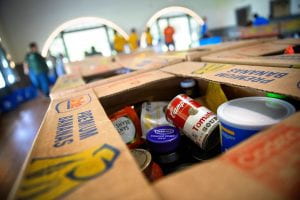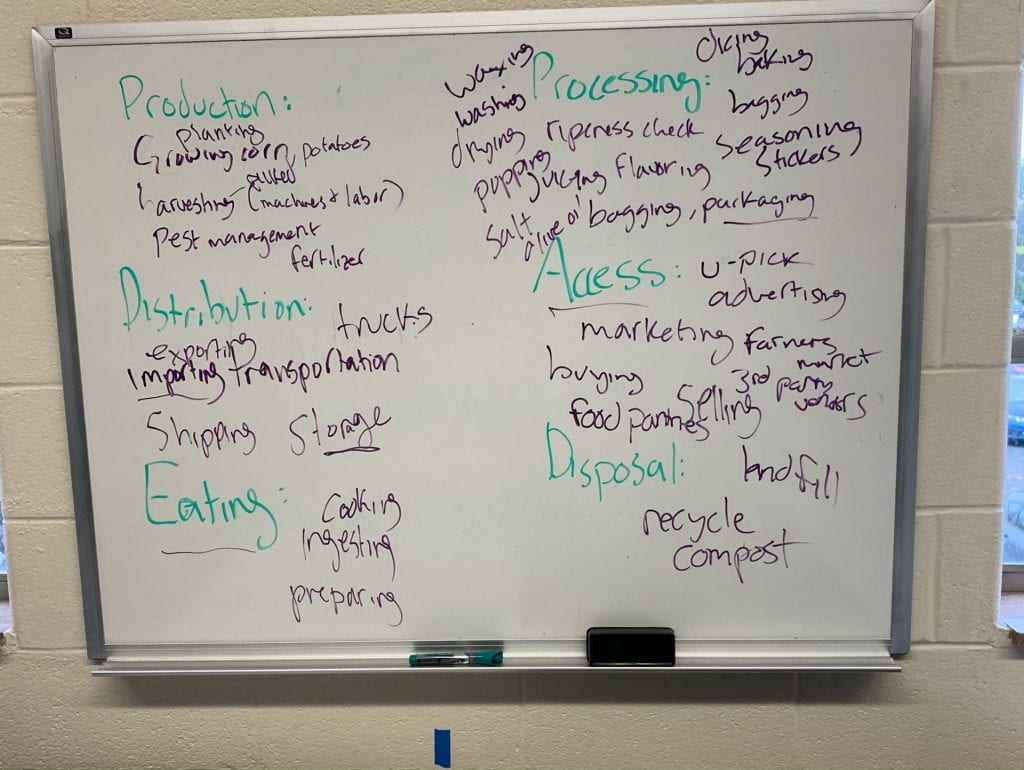 Skill Level
Skill Level
Beginner, Intermediate, Advanced
Learner Outcomes
- Identify the steps a common snack food takes from field to fork.
- Recognize that the food system is complex.
- Begin to understand what their role in the food system can be.
Life Skills
Critical thinking, learning to learn, communications, social skills, accepting differences, sharing, contribution to group, marketable/useful skills, teamwork, self-responsibility, character, managing feelings
Time
30-45 mins
Materials
- Surface to write on and writing utensil (e.g. whiteboard, large sheet of paper + tape, etc.)
- Pens or pencils
- A Snack’s Journey handout for each youth
- Simple plant-based snacks appropriate for your group (ex. popcorn, apples, grapes, carrots, bananas, etc.). Creators of this curriculum have found popcorn to be a wonderful choice for this activity.
Space
Any space that allows group work, eating snacks, and writing
Introduction
In this activity, youth will begin to develop awareness about where their food comes from. As human beings, we eat food. We all participate in the food system every day, whether we know it and choose to reflect on it or not. The food system is complex. It affects the environments we live in, our health, the earth’s health, the economy, the government, and much more. To begin understanding its effects, we will take a snack’s journey through our food system exploring how our food is grown, processed, distributed, accessed, eaten, and disposed of. Developing an awareness and understanding of our food system and its many parts and complexities is one thing we can do to empower ourselves to create change and make informed decisions about the food we eat.
As mentioned above, the food system is complex. Furthermore, as the facilitator, it is important to recognize the food system does not function the same for all people. Even for people living in the same city, the food system can manifest itself in different ways. In the past and present, there have been structural barriers to food access and sovereignty. Low-income communities, indigenous communities, and communities of color have been especially impacted by these barriers.
“Vote with your fork” is a social change strategy promoted by some food movements in this country. This strategy depends on peoples’ food purchasing and eating choices to create change in the food system. This strategy can be effective, and yet we must keep in mind that this may not be a viable strategy for all members of our society. There are complex social and economic factors sometimes preventing low-income communities, indigenous communities, and communities of color from accessing healthy, affordable, and culturally appropriate food. Supermarket access, food prices, education, and employment are just a few of these factors. The relationship between food and cultural identity is significant. It is important to keep this in mind when facilitating. These are themes we will continue to discuss throughout the curriculum.
We encourage the facilitator have open and honest dialogue about the food system and empower youth to create their own opinions of the food system. Given the challenges of understanding something so widely varying and complex, as the facilitator, you may find yourself saying “I don’t know.” This is an opportunity for young people to experience the “not knowing” and we encourage you to collaborate to find answers to your questions.
Vocabulary
System: a set of interdependent parts forming a complex whole; a set of principles or procedures according to which something is done
Food system: the journey that food travels from field to fork and beyond, which includes growing, harvesting, processing, packaging, transporting, marketing, consuming, and disposing. It includes the inputs needed and the outputs generated at each step
Food Security: the state of having reliable access to a sufficient quantity of safe, affordable, and nutritious food
Food Justice: a person’s right to affordable, nutritious, fresh, and culturally appropriate food regardless of race, class, gender, ethnicity, citizenship, ability, religion, or community
Food Sovereignty: the right of peoples to healthy and culturally appropriate food produced through ecologically sound and sustainable methods, and their right to define their own food and agriculture systems (term coined by International Peasants’ movement La Via Campesina and defined in the 2007 Declaration of Nyéléni)
Parts of the food system:
Growing: All steps involved in producing the raw food. Steps could include farming, foraging, fishing, gardening, planting seeds, applying fertilizers, watering crops, harvesting, storage, and more.
Processing: All steps needed to prepare food for distribution and eating. Steps could include packaging, chopping, canning, preservation, adding spices, enriching with nutrients, cooking, slaughter, deboning, and more.
Distributing: All steps and materials involved in transporting food to places of access and eating. Steps and materials could include wholesaling, warehousing, transportation, trains, trucks, ships, cars, and more.
Accessing: This is how we obtain our food through various societal constructs including retail (ex. farmers market, supermarket, box stores), institutional food service (ex. schools, hospitals, jails, places of worship), emergency food programs (ex. food pantries), family gatherings, and more. Marketing can be an important component of access.
Eating: All steps needed to consume food. This could include cooking, preparing, purchasing, celebrations, rituals, and more.
Disposing: This is what happens to food scraps and packaging after eating. Disposal could include composting, sending waste to the landfill, renewable energy, animal feed, and more.
Before the Activity
- Write the following questions on the board or a large sheet of paper hung up where everyone can see it.
•What is a system?
•What is a food system? - Prepare snacks.
Activity
Opening Questions
- Have the youth break off into groups of two to three people to answer the following questions:
•What is a system?
•What is a food system?
Experience
- Come back together to discuss answers and using the answer the key as a guide, develop a definition for “food system.” Write this definition on the board.
- Ask the youth to split into groups of three or four; give each group a snack, writing utensils and A Snack’s Journey handout. Provide instructions:
•Inform the youth that they may eat their snacks.
•Share that each group will write their snack’s journey through the food system by identifying the possible activities involved in each listed part of the food system. Depending on skill level, make sure participants understand what each part of the system means. For each part, have youth think about who is involved, what the inputs are, and if there is any waste.
•While groups are meeting, write the six parts of the food system (growing, processing, distributing, accessing, eating, disposing) on a board or a large sheet of paper hung up where everyone can see it. - Gather back together as a whole group. For each section of the food system, ask the youth what their snack was and the activities they wrote down. Add and discuss any activities that they have not mentioned.
Reflection Questions (choose a few that work best for your group)
- How did it feel to do that activity? How did it feel to work in groups?
- Do you have any thoughts or feelings that you did not expect?
- Where do you see yourself in the food system?
- Do you know anyone whose job is involved in the food system? (e.g. farmer, truck driver, grocery store worker, etc.)
- In what other systems do you participate?
- If you had to teach someone about the parts of the food system, how would you do it? Where would you start?
Variations
- Instead of writing on the worksheet, groups could draw out each step. For beginners, the facilitator could create a matching game for youth to match each step with its part in the food system.
Extensions
- Take a field trip to a farm, processing plant, or landfill.
- Invite a politician, university researcher, farmer, processing plant worker or anyone else involved in the food system in as a guest speaker, letting them know in advance tips on how to make their presentation age appropriate for youth.
Learn More
- Agriculture and Food Systems New York State 4-H
- Food First Backgrounder on Racism in the Food System
- Food Justice FoodPrint
- Reform or Transformation? The Pivotal Role of Food Justice in the U.S. Food Movement Race/Ethnicity: Multidisciplinary Global Contexts
- The New Face of Hunger National Geographic
- The Pleasures of Eating by Wendell Berry
Curricula and lesson plans
- Discovering Our Food System Cornell Garden-Based Learning
- Food! How Do We Ensure Good Nutrition for All? Smithsonian Science Education Center
- Food for the SOL Seeds of Solidarity Education Center
- Food Systems Feed the World National Agriculture in the Classroom
- Food Systems for Thought and Change National 4-H at Home Series
- Food Systems Thinker by Mingla Charoenmuang, Purdue University
- FoodSpan John Hopkins Center for a Livable Future
- The Food Project
Videos
- Follow that Food – Carrot Edition Minnesota Department of Agriculture
- Future of Food – Feeding the World in a Sustainable Way | Chiara Cecchini | TEDxKlagenfurt
- Prickly Pineapples: From Farm to Fork Tesco Eat Happy Project
- Food Systems Approach by WUR explained in 1 minute Wageningen University & Research
- Voices of the Food Chain by Food Chain Workers Alliance, Real Food Media
Acknowledgements
Components of this activity taken from activities in Discovering Our Food System (“A Meal’s Origins” and Youth Grow (“Defining a Food System”).



